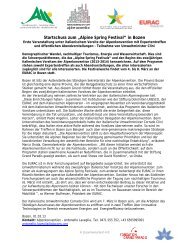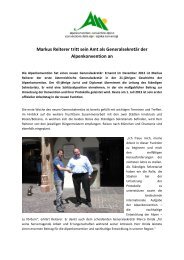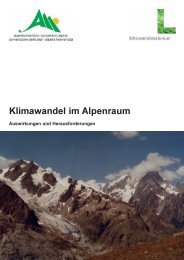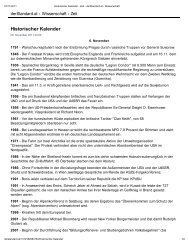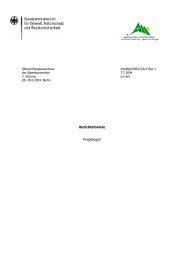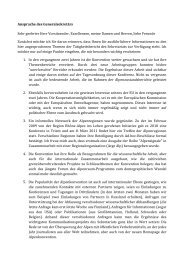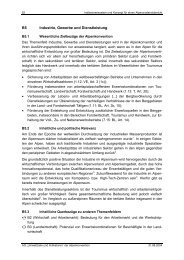ALPINE CONVENTION - Convenzione delle Alpi
ALPINE CONVENTION - Convenzione delle Alpi
ALPINE CONVENTION - Convenzione delle Alpi
Create successful ePaper yourself
Turn your PDF publications into a flip-book with our unique Google optimized e-Paper software.
46<br />
Map 4: Population development – Population development in the municipalities<br />
Currently 14.01 million people live in the territory<br />
of the <strong>Alpi</strong>ne Convention. Never before have so<br />
many people lived in the Alps. Most of the Alps’<br />
inhabitants reside in the Italian and Austrian <strong>Alpi</strong>ne<br />
territories (see table 2).<br />
The years from 1990 to 2007 saw a population<br />
growth of roughly eight percent. This makes development<br />
in the <strong>Alpi</strong>ne arc more dynamic than<br />
the EU average (plus five percent; Eurostat 2007).<br />
This has not always been so. Only since the<br />
1970s has population growth in the <strong>Alpi</strong>ne arc<br />
been higher than that in the rest of Europe. Only<br />
Austria and Slovenia have a national rate that is<br />
higher than that of the whole of the Convention<br />
Territory. Population development is not equally<br />
distributed among the regions. More than two<br />
thirds of the <strong>Alpi</strong>ne municipalities have seen positive<br />
development (see table 3). Positive development<br />
is to be found especially in municipalities<br />
showing prosperous economic growth and located<br />
in lower and easily accessible regions. Moreover,<br />
regions towards the margins of the Alps,<br />
<strong>Alpi</strong>ne signals 1<br />
in proximity to the great metropolises, are marked<br />
by positive population dynamics. Corresponding<br />
to the overall European tendency (periurbanisation),<br />
the population of municipalities in the surroundings<br />
of <strong>Alpi</strong>ne centres (Bozen/Bolzano,<br />
Innsbruck, Lugano, Trento, Grenoble) is growing.<br />
Stagnation or decrease in population, on the<br />
other hand, can be found in peripheral spaces or<br />
in regions experiencing economic depression. In<br />
the years from 1990 to 2004, 24 percent of the<br />
municipalities in Convention Territory saw declining<br />
population figures (see table 3).<br />
Despite the large number of small municipalities,<br />
there is a certain concentration process noticeable<br />
in the <strong>Alpi</strong>ne Arc. More than 73 percent of the<br />
population is concentrated in the 23.7 percent of<br />
municipalities that have more than 2,500 inhabitants.<br />
By contrast, as few as 8.8 percent of the<br />
Alps’ inhabitants live in the approximately 50<br />
percent of municipalities that have less than 1,000<br />
inhabitants. Only 14 municipalities have more<br />
than 50,000 inhabitants.





